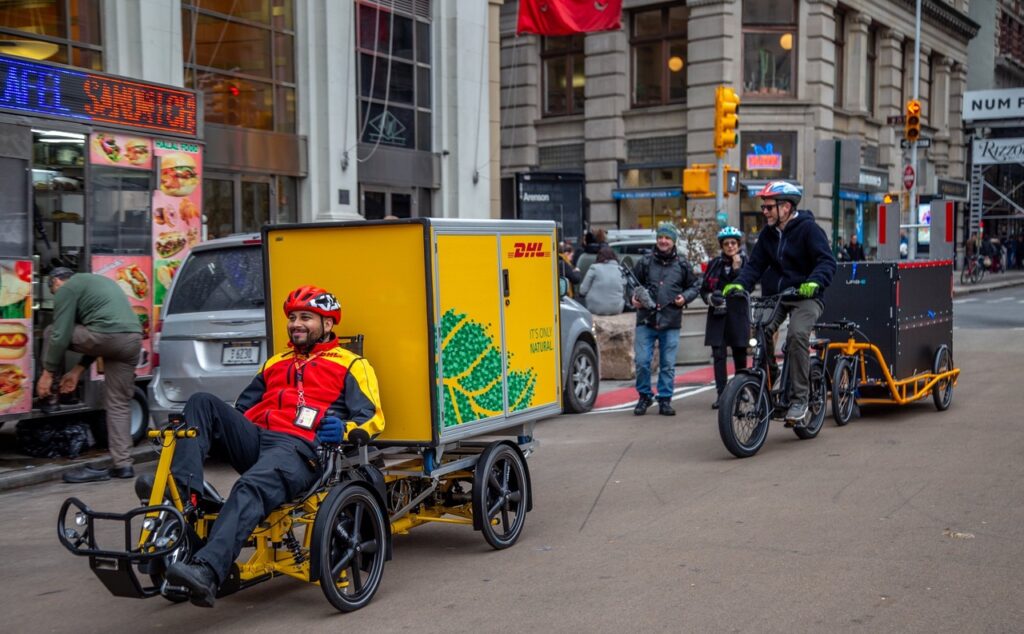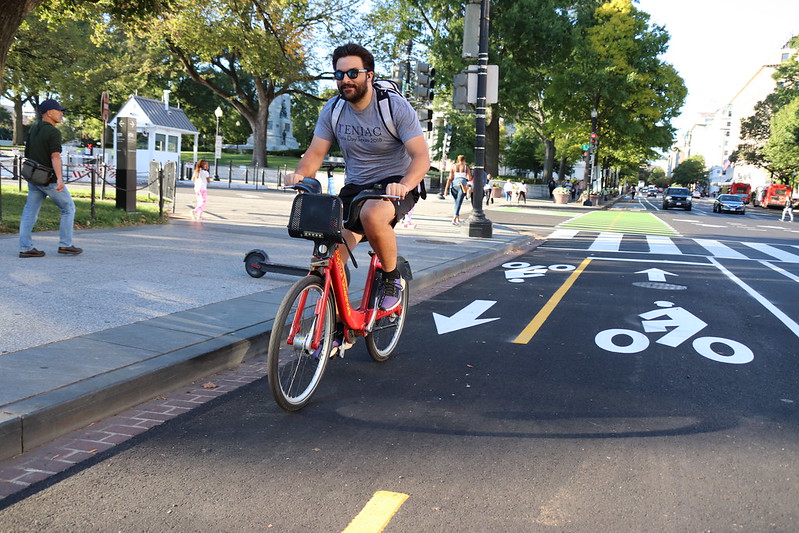
Catching the e-bike wave

Electric bikes have enormous potential to deliver affordable, clean, healthy and space-efficient transportation to the masses, but the feds and too many other leaders are passing up this opportunity in favor of electrifying the status quo.

Photo by Elvert Barnes on Flickr.
The best selling type of electric vehicle in the U.S. is traffic-busting, space-efficient, healthy, and doesn’t require a drop of gas—but it’s not an electric car. Talk to anyone who owns an electric bicycle and you’ll get an earful on how practical, fun and life-changing these machines are. You have all the fun of being on a bike, but the power assist makes the hills flat and keeps you from breaking a sweat. E-cargo-bikes make carrying larger loads easy, replacing car-trips to the grocery store and helping to shuttle kids to school and activities. Maybe all this—and their relative affordability—is why, as both markets grow rapidly, e-bike sales continue to outpace electric cars.
The tsunami of e-bikes entering the transportation mix is great news for smart growth. E-bikes and other electric micromobility devices, like electric scooters, are relatively affordable and powerful transportation tools that, like regular bikes, also fit well in dense walkable places. Federal, state and local governments should catch this wave.
Safe infrastructure, parking and incentives
If we’re going to invest public dollars in electric transportation, e-micromobility is a place where we can get equity, environment and smart growth outcomes along with emissions reduction. How do we do it? It comes down to three overarching strategies: safe bike infrastructure, encouraging people to buy and use e-bikes, and creating parking solutions that work for this unique form of transportation.
1. Safe bike infrastructure
Unsafe streets are likely the biggest impediment to e-bike adoption. Safe streets for cycling have always made sense, but the enormous potential of e-bikes is one more reason to invest in these networks.
Piecemeal efforts with only paint are not enough. We need Complete Streets policies and standards, taking bike accessibility into account with every investment. These policies and standards need to be strong enough to build bike networks that are protected from cars and trucks and connected to destinations. This can and should be applied at every level of government.
2. Encouraging people to buy and use e-bikes
Many states and cities are rolling out e-bike purchase incentive programs to good effect. This makes sense. E-bikes deliver all the benefits discussed above, and they’re much more affordable than cars. For a typical public subsidy on an electric car, you could purchase an e-bike outright.
Because of their price tag, getting e-bikes and e-cargo bikes into the hands of families that can’t afford a car is a big transportation equity move. People for Bikes’ E-Bike Incentive Design Tool provides guidance for states and cities looking to launch a local program. At the federal level, Congress should pass the E-BIKE Act and help deserving families acquire e-bikes nationwide.
Bikeshare programs are also seeing a lot of success in delivering clean, healthy, space-efficient mobility while exposing more people to the magic of electric bikes. Bikeshare and electric scooter sharing programs are a great complement to public transit, as they can help close first- and last-mile gaps in people’s commutes and give people an additional option for getting around on nights or weekends when transit runs less frequently. Shared micromobility also provides access to these options for people who can’t afford their own e-bike or don’t have a place to store it. Governments at all levels should view shared micromobility as fundamentally a form of public transit and support it with public investment.
To support shared micromobility in the near term, we need a “dig once” approach to installing charging infrastructure for shared micromobility and EV charging infrastructure. That is, when we install charging infrastructure for cars, we should seek opportunities to co-locate car charging infrastructure with charging for shared micromobility. The North America Bikeshare and Scootershare Association (NABSA, a member of the CHARGE coalition that T4America co-leads) recently released a report on co-locating EV and micromobility charging which decision-makers should take heed of. While the Biden Administration’s Joint Office on Energy and Transportation talks a lot about multimodalism, Community Charging Grants in the infrastructure law’s Charging and Fueling Infrastructure (CFI) program currently only fund car charging. Really, all federally funded charging infrastructure should be built to charge bikes and scooters too.
3. Parking considerations
E-bikes are heavier and more expensive than regular bikes, and their batteries need to be charged. These differences mean that parking for e-bikes requires special consideration. E-bike parking, especially overnight, needs to be secure. Parking facilities in places like apartment buildings and workplaces need to have level entry, and can’t require the owner to lift the bike onto a hook. Accommodating space for cargo bikes is also becoming more important. Most e-bikes have removable batteries that can be charged in the home or at your desk, so charging in the bike room might not be entirely necessary. Local governments will have to develop bike parking standards that take these special considerations into account and JOET can assist by developing guidance.
The bottom line
The investments needed for us to catch the e-bike wave are relatively modest compared to the pay-off. If we succeed, we’ll be sitting on top of the world! Following the strategies outlined above can help maximize the potential of this small but mighty form of electric transportation.
In our EV blog series, we’ve shared strategies in the zero-emission fleet transition which work in concert with smart growth. These strategies can both advance the EV transition and reduce the need to drive so much. They include electric carshare services, charger-oriented development, the NEVI program, equitable access to chargers, integrating smart parking policy with EV-charging, and electric micromobility. To learn more about reducing transportation emissions, check out our report Driving Down Emissions and go here to learn more about CHARGE, the coalition we co-lead on EV issues.



